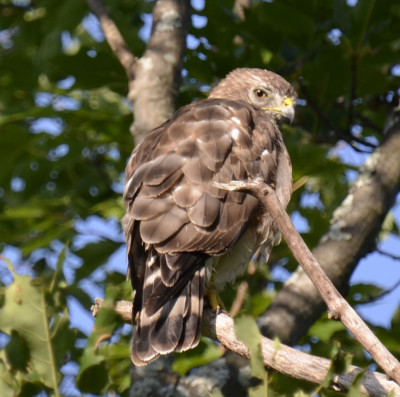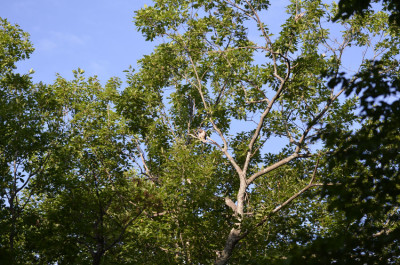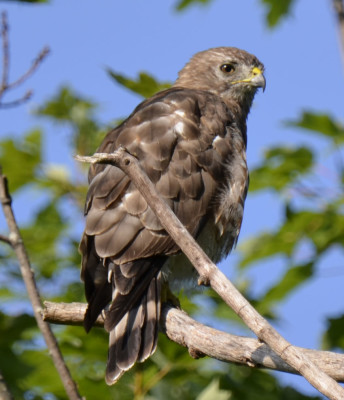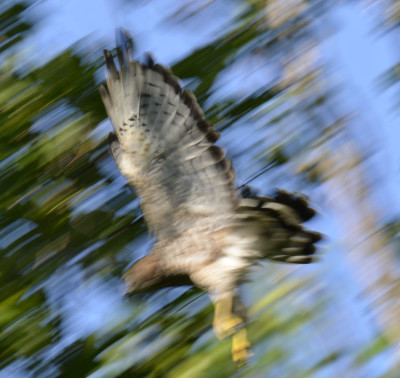I’m sometimes lucky enough to get to visit a cottage in the Canadian Shield not far from Sharbot Lake, Ontario. The area is a mixture of woodlots and farm fields with a variety of marshes, swamps and lakes to keep it interesting. The trees include maples, oaks, and birches, but also pines and hemlocks. Most of the larger predatory birds are regular residents here: Red-tailed Hawks, Belted Kingfishers, Bald Eagles, Cooper’s Hawks, Ospreys, the usual suspects. So when a hawk sailed out of the forest to land on a tree near the road I was ambling along, I expected to see a familiar bird—but I didn’t.

Is it just me or does this bird look annoyed that I was still there?
Never Try to Take Photos of a Bird More Than 10 Metres Up a Tree and 15 Metres Away with a Macro Lens
As you might expect given my natural flair for inappropriate luck, while I did have my camera out when the hawk landed it was loaded with a macro lens. (I’d been taking photos of the damselflies and flowers along the roadside.) Hardly an ideal lens for a bird perched way up and way far away! Still, I took several photos immediately because I know that birds can leave as quickly as they arrive.
Look for Patterns on the Hawk’s Front Feathers to Start Identifying It
Through the lens I could see the hawk had lines across the front. Not just the vertical streaks of a Red-tailed Hawk’s belly band but more the kind that Cooper’s Hawks sport. They weren’t as finely lined though. And the head didn’t look right at all: it was overall dark and so was the throat and neck.

You can see the head and neck are dark and the chest is striped and the shape is bulky but not much else.
Hoping like mad that the bird wouldn’t fly. I gently shrugged off my knapsack and started changing my lens to a telephoto. Of course the mosquitoes that had been encouraging me to keep my hands in my pockets during my walk thought this was a great idea. So as well as the odd motions I was making, I was also puffing air out attempting to blow mosquitoes out of my eyes and off my nose. Goodness knows what the bird thought of all this: you can see in the photos that it was watching me perhaps in amusement.
Check a Hawk’s Tail for My Identification Clues
Fortunately, for once, the bird actually stayed perched until I could try again. Of course it turned its back on me and never did show its front side again. But still, I was very, very pleased to get a closer look.
The tail had black and white horizontal bands, like a Cooper’s or a Sharp Shinned Hawk, but there didn’t seem enough bands and the tip wasn’t noticeably white through the lens. Again, the head seemed wrong and the bird seemed too bulky—but it had been soaking up the sun when it first landed so I wasn’t sure if it was still puffed up.
Hawk Wings in Flight Can Help Decide the Type Quickly
Fortunately, I had the lens up when it finally flew several minutes later. I didn’t have it set to rapid fire, so the flight shot is very blurry, but it has been quite useful for identification reasons. As you can see, this bird does not have a narrow black mark along the front edge of the wings. It does have a black line along the trailing or back edge though. And the shape of those wings rules out Cooper’s and Sharp Shinned immediately.
A look at the old copy of Peterson’s Field Guide to the Birds of Eastern Ontario back at the cottage confirmed my suspicions. This was a Broad-winged Hawk. I’d seen them, way up high, during migration, but I’d never before seen one up close.
(To be doubly sure, once my mini-vacation was over and I had internet access again, I posted the photos to a bird chat website and asked the opinion of the more experienced bird watchers. They agreed it was a Broad-winged.)
What Do Broad-winged Hawks Eat?
Now that I knew what type of hawk it was, I wondered what it was hunting that morning. I checked the AllAboutBirds website for an overview of this type of hawk. It says they hunt in forest clearings near lakes and that their favoured prey includes “small mammals, amphibians and insects.”
Well, if they like chipmunks they’d be happy where I was walking. There was another Chipmunk chirking its territory every 30 metres!
The call of a Broad-winged is a sharp whistle. I listened to the recording on the Cornell website but I don’t think I’ve ever heard one. I’ll be more aware of that type of call in the future, though.
Should You Publicly Report Birds Popular with Photographers If They Aren’t Endangered or Threatened?
It left me with an ethical puzzle though. Normally, I report my more interesting bird sightings on eBird. But this bird had been seen from a private (not public) road on private property. People in the area value their privacy and the peace and quiet. If I reported it, would it draw the attention of any photographers with weak respect for the rules? I still haven’t decided whether to report the bird or not. I do see that other Broad-winged Hawks have been reported within a 20-km radius but not this year. They are not an unusual hawk nor are they endangered so I probably won’t report the sighting, at least for now.
Related Reading
Join In
Have you seen a Broad-tailed Hawk on its breeding territory? Or only as one of the tiny dots soaring up on thermals during migration? Please share your sighting with a comment.




